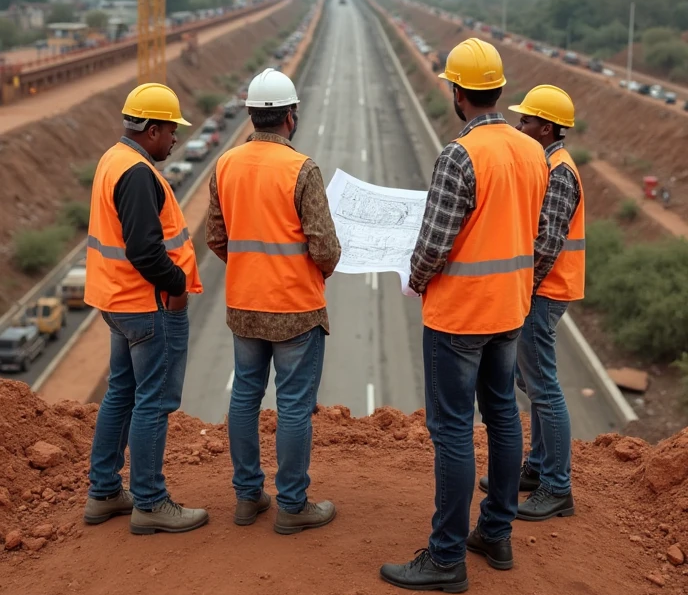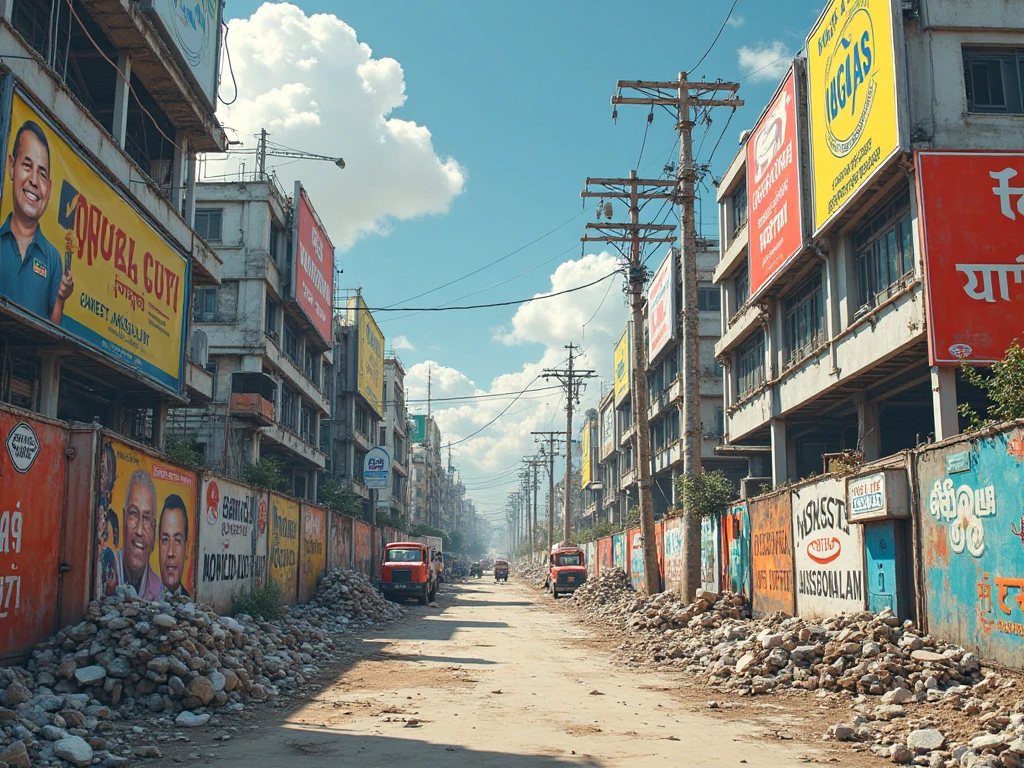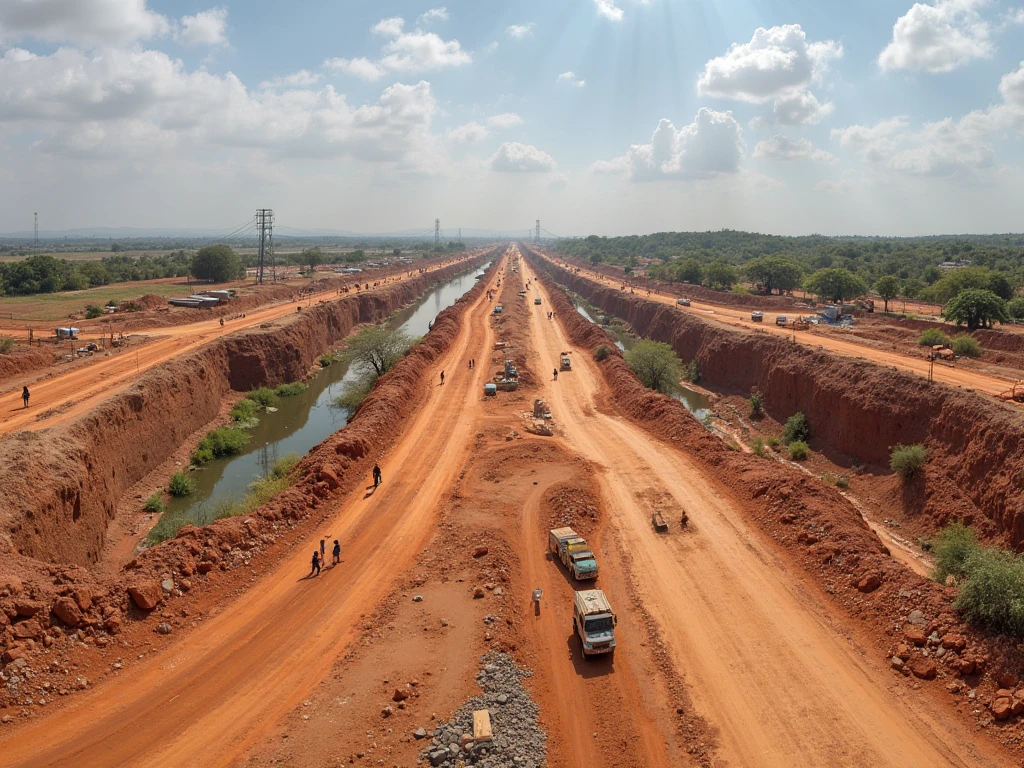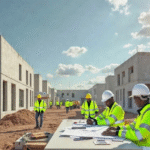Discover 10 Project Management Challenges Facing African Infrastructural Projects
Building better infrastructure is key to Africa’s economic transformation. It will make it easier for people to connect, everyone’s access to basic services will increase, and the continent’s economy will thrive. Infrastructure projects on a large scale, like highways, bridges, energy grids, and water systems, are essential to national development plans. These projects are significant, but they typically run into many problems with project management that make it challenging to finish them on time and in a beneficial way.
Project managers in charge of these advancements must confront many problems, including limited finances, changing political situations, and technological issues. These issues could hinder the project’s completion and undermine community trust and long-term sustainability. This article looks at ten of the most prevalent project management challenges in African infrastructure development and offers real-world solutions for strategic planning.
What is Project Management?
Project management involves using skills, knowledge, experience, and processes to achieve specific project goals within agreed-upon limits. It consists of initiating, strategising, executing, monitoring, and concluding tasks to accomplish the project’s objectives and deliverables.
Project management ensures that complicated tasks like building roads, power grids, or water supply networks are finished on schedule, on budget, and to the right quality standards for infrastructure. To manage projects in Africa well, you need to know a lot about the local ecosystems and the problems affecting the whole system.
Who is a Project Manager?
The project manager is in charge of planning, carrying out, and finishing a project. They are responsible for ensuring all stakeholders agree, maintaining the project’s progress, staying within budget, satisfying client expectations, and meeting quality requirements. Project managers are essential in infrastructure development because they manage resources, settle disputes, mitigate risks, and follow rules. Their leadership is a key determinant in whether a project works out.

Key Project Management Challenges in African Infrastructure
Project managers in Africa must confront specific management problems caused by the economy, politics, and environment while running a project. Common risks in project management can arise from factors such as inadequate planning or external events like political instability. Here are ten of the most critical project management challenges that project managers face when working on infrastructure projects in Africa:
1. Funding Constraints and Financial Mismanagement
Many infrastructure projects in Africa struggle to raise enough money on schedule and manage it well. Complicated bureaucratic processes, poor financial planning, and limited institutional competence often delay funds or completely stall projects. Uneven government budget allocations and excessive reliance on donor funds complicate cost estimation, a crucial aspect of effective construction budget management.
The problem becomes worse when money is mismanaged. Corruption, theft, and a lack of accountability are common societal problems that have made domestic and foreign investors less likely to invest. For example, stakeholders may lose faith in a project if there are problems with the budget or if there aren’t any independent audits. Such circumstances can also raise the project’s costs. To re-establish trust and ensure that African construction projects can last, excellent financial governance and openness must be established.
According to France 24, President Donald Trump instructed the 2004-founded Millennium Challenge Corporation (MCC) to cease operations in 2025. Because of this, the group will suspend US-funded projects in Africa, like roads and new electrical grids, which already have big problems and may never be completed.
2. Poor Stakeholder Engagement and Communication
African infrastructure projects often overlook stakeholder management. Sometimes, decision-making excludes local communities, financiers, NGOs, and regulatory agencies, resulting in resistance, delays, or even project cancellation. Often, contractors and project managers fail to adequately inform or consult affected populations, resulting in mistrust and conflict.
Improved communication strategies and inclusive stakeholder frameworks can mitigate these project management risks. Establishing grievance redress mechanisms and community liaison offices helps build trust and enables smoother project execution. The Lesotho Highlands Water Project is a positive example of engaging multiple stakeholders effectively across borders.
3. Political and Regulatory Instability
Managing construction projects becomes challenging when politics interfere and regulatory rules/laws are unclear. When the government has a new leader, its policies or priorities usually alter. This issue may lead to the suspension, review, or even cancellation of ongoing projects. Additionally, awarding contracts and purchasing 2oods from corporations for political reasons may result in unqualified companies managing significant projects.
Setting up independent regulatory organisations unaffected by political cycles can lower this risk. Botswana is a positive example of how independent regulatory organisations can ensure that project management in Africa remains consistent even when governments change.
4. Procurement and Contractual Disputes
Non-transparent procurement processes are a frequent cause of inefficiency in African infrastructure delivery. Bribery, favouritism, and a lack of competitive bids result in poor contractor selection, which leads to project delays, cost escalations, or substandard work. Disputes over unclear or biased contract terms further burden already fragile project timelines.
Enforcing standardised procurement procedures and adopting digital platforms for tendering can enhance fairness and transparency. Kenya’s e-procurement system has recently helped streamline contractor selection and reduce corruption risks.
5. Inadequate Project Planning and Feasibility Studies
Inadequate planning is a significant bottleneck to successful construction projects in Africa. Projects frequently commence without detailed feasibility studies, leading to flawed cost estimates, ambiguous deliverables, and misaligned expectations. As a result, construction halts midway due to budget overruns or foreseeable scope changes.
Robust project planning involves economic viability assessments, environmental impact analysis, risk profiling, and stakeholder consultation. Without these components, project management in Africa is more susceptible to failure. Countries like Rwanda and Morocco have begun investing in pre-project evaluation processes to enhance the reliability of our infrastructure and ensure long-term success.

6. Inadequate Technical Capacity and Human Resources
Africa has a shortage of skilled professionals such as engineers, quantity surveyors, environmental experts, and project managers. Many graduates lack practical training, and public institutions often struggle to attract and retain talented individuals. This skills gap results in outsourcing to foreign firms, escalating costs, and reducing local knowledge transfer.
Investment in local capacity through university-industry partnerships, vocational training, and certification schemes is critical. Homegrown engineers support Ethiopia’s GERD’s success, demonstrating how deliberate effort in project management in Africa can achieve technical self-reliance.
7. Logistics and Supply Chain Challenges
Infrastructure projects often encounter problems with getting and moving materials. Africa faces challenges moving heavy gear and construction supplies due to the lack of modernised and expansive roads, railroads, and ports. Customs delays and broken supply chains make schedules even more challenging to follow.
Investing in regional trade corridors and designing logistics in a way that takes all of these factors into account will help lessen these problems. The African Continental Free Trade Area (AfCFTA) wants to make customs procedures easier and make it easier for countries to work together on big infrastructure projects.
8. Environmental and Social Impact Pressures
If you don’t follow ecological rules or don’t do anything to lessen the social effects, communities and international donors may not support you. Certain nations have halted projects or filed lawsuits due to environmental damage, forced relocations, and health issues.
Environmental and Social Impact Assessments (ESIAs) and unchangeable compensation and resettlement plans should accompany every infrastructure project. At first, Ghana’s Akosombo Dam project was controversial, but it later became a model for environmentally friendly administration that includes everyone.
9. Poor Monitoring and Evaluation Systems
Lack of real-time data, reporting mechanisms, and key performance indicators (KPIs) severely undermines project execution. Many African governments lack central monitoring systems or fail to act on periodic evaluations, leading to repeated mistakes and cost inflation.
Digital project management tools and independent oversight bodies can improve tracking and accountability. For instance, Rwanda uses GIS and data dashboards to monitor construction projects in Africa, helping prevent delays and cost deviations.
10. Maintenance and Sustainability Neglect
Many initiatives fail within a few years because they lack maintenance plans or money. Infrastructure falls apart quickly when project frameworks don’t include preventive measures and lifecycle costs.
Long-term asset management plans and institutional frameworks are essential. Tanzania and Zambia have demonstrated that establishing dedicated road or utility maintenance funding helps ensure infrastructure longevity and maintains public satisfaction over time.

Case Studies: African Projects that Faced and Overcame Management Challenges
To better understand how theoretical challenges translate into real-world complexities—and more importantly, how project management challenges can be overcome—it is advantageous to examine infrastructure projects across Africa that have faced and addressed various project management difficulties. These case studies highlight the obstacles encountered and the strategies employed to deliver significant infrastructure developments successfully under pressure. They are tangible examples of resilience, innovation, and leadership in adversity.
1. Mombasa-Nairobi Standard Gauge Railway (Kenya)
This SGR flagship railway project encountered significant challenges, primarily around land acquisition, political interference, and cost overruns—compensation disputes with affected landowners and delays caused by inefficient regulatory processes created project standstills. Public dissatisfaction and environmental concerns also threatened progress.
The Kenyan government set up structured land acquisition frameworks to overcome these problems. These made it easier to pay people back and cut down on arguments. Regulatory organisations worked better together, and China gave both sides money, making things more stable. Better cooperation between government departments and technical teams helped finish the project, which made trade and commuting more efficient in the area.
2. Grand Ethiopian Renaissance Dam (Ethiopia)
The project grappled with several critical challenges, including funding gaps, strained diplomatic relations with downstream countries, and uncertainties regarding technical feasibility—concerns about water sharing, environmental impact, and lack of transparency added to the geopolitical tension.
To tackle these obstacles, Ethiopia started a new domestic bond drive to gather money from its residents and diaspora to help it deal with these problems. This initiative made the project less dependent on foreign aid. At the same time, the government was actively negotiating with other countries to deal with outside influences—phased building allowed for flexible engineering responses and improved control over project risks and costs.
3. Lagos Light Rail (Nigeria)
The Lagos Light Rail faced project delays rooted in fragmented government policies, shifting priorities, and a lack of contractor accountability. Poor initial planning, financing issues, and political turnover further complicated execution, causing public skepticism and logistical setbacks.
In response, the Lagos State Government overhauled the project’s management strategy. International consultants were brought in to advise on project delivery models, and a modular implementation approach was adopted to ensure incremental progress. These measures restored public confidence and reinvigorated project momentum.
4. Kigali Bulk Water Supply Project (Rwanda)
Initially, the Kigali bulk water supply project initiative faced several challenges, including a lack of local experts, insufficient investors, and difficulties securing adequate upfront funding. It was challenging to acquire and keep. The Rwandan government sought private sector partners due to technical problems with water management and concerns about long-term sustainability threats.
The Rwandan government solved these problems using a Build-Operate-Transfer (BOT) approach that included private investors with experience. Capacity-building programs trained local workers throughout the project’s life, and legally binding measures spread risk fairly between public and private parties. This method provided city dwellers with a necessary water supply system.
| Project | Outcome | Metrics | Impact |
| Mombasa-Nairobi Standard Gauge Railway (Kenya) | Completed and operational | 472 km rail completed; Cost: $3.2 billion; Reduced Mombasa-Nairobi travel time from 12 hours to 4.5 hours | Boosted cargo and passenger movement; improved regional trade, and created over 30,000 jobs during construction |
| Grand Ethiopian Renaissance Dam (Ethiopia) | Nearing full capacity with major generation phases completed | 6,450 MW installed capacity; Over $5 billion in funding mobilised; 70% domestic financing | Enhanced national energy security, increased regional geopolitical leverage, and created thousands of jobs |
| Lagos Light Rail (Nigeria) | Phase 1 nearing completion after restructuring | Blue Line spans 27 km; Modular rollout in progress; and the estimated cost is $1.2 billion | Improved urban transit, reduced traffic congestion, and restored public confidence in urban transport planning |
| Kigali Bulk Water Supply Project (Rwanda) | Operational with sustainable public-private financing | 40 million liters/day capacity; BOT agreement over 27 years; ~500,000 people served | Improved urban water supply, enhanced investor trust in PPPs, and strengthened local utility capacity |

Project Outcomes and Metrics: Strategic Recommendations to Overcome Challenges
To solve the ongoing project management challenges in Africa, we need more than just identifying them. We need solutions that can be implemented and are sensitive to the continent’s complicated infrastructure. The following recommendations provide a roadmap for improving the planning, execution, and sustainability of infrastructure projects.
Both on-the-ground experiences and global best practices inform these solutions. These best practices strengthen institutional capacity, enhance transparency, and build long-term resilience across African construction projects.
1. Invest in Capacity Building
Empowering African professionals through technical training, mentorship, and certification programs can significantly reduce reliance on foreign consultants and create a pipeline of capable talent for future infrastructure projects. National governments and educational institutions should collaborate to design programs that match industry needs while incorporating soft skills like leadership and digital literacy. For example, Kenya’s and Ethiopia’s Technical and Vocational Education and Training (TVET) programs have improved workforce readiness for large-scale engineering projects.
2. Strengthen Institutional Frameworks
A significant barrier to efficient project delivery in Africa is the lack of streamlined institutional processes. Governments can mitigate delays and ensure consistency by simplifying permitting and approval workflows, standardising procurement procedures, and reducing regulatory redundancies. Rwanda’s electronic single-window clearance system for investment projects has become a model in East Africa, allowing faster approvals and better stakeholder coordination.
3. Enhance Transparency and Accountability
Infrastructure projects often suffer from mistrust due to opaque budgeting and corruption. Adopting digital platforms for project tracking, using blockchain to verify procurement chains, and commissioning independent audits can foster greater public and donor confidence. Nigeria’s Bureau of Public Procurement has taken steps in this direction by launching an open contracting portal that tracks real-time procurement processes and spending.
4. Promote Public-Private Partnerships
Given the significant capital demands of infrastructure development, leveraging the private sector is not just optional—it’s essential. By creating clear legal frameworks, risk-sharing mechanisms, and dispute resolution clauses, governments can attract private investors while ensuring accountability. South Africa’s Renewable Energy Independent Power Producer Procurement Programme (REIPPPP) is a successful PPP initiative that has brought billions of dollars in private investment.
5. Integrate Risk and Climate Resilience Planning
African infrastructure must be resilient to the growing threats of climate change, political volatility, and natural disasters. Risk assessments should be integrated with climate-resilient designs such as elevated roadways, stormwater infrastructure, and disaster-proof building codes at the planning stage. The Eko Atlantic City development in Lagos, Nigeria, integrates coastal defence systems into its urban planning to mitigate the effects of sea-level rise.
6. Institutionalize Lifecycle Maintenance
Many infrastructure projects in Africa fail prematurely due to poor maintenance planning. Governments must embed lifecycle costing into project designs and allocate regular funding for inspections, repairs, and system upgrades. Kenya’s Road Maintenance Levy Fund (RMLF) is one example of a policy-driven mechanism that provides consistent funding for the upkeep of national roads, ensuring long-term usability and reducing reconstruction costs.

Conclusion
Africa’s broader socioeconomic, political, and technical contexts deeply intertwine with project management challenges. Each issue, from limited funding to capacity constraints and environmental risks, presents a unique hurdle that requires diligence and strategic foresight. However, successful projects across the continent demonstrate that targeted interventions and strong leadership can effectively address the above project management challenges.
To drive meaningful change, governments must prioritise policy reforms, capacity building, and stakeholder collaboration. Equally, private sector actors and international development partners must continue to offer financial, technical, and institutional support to bridge critical gaps. With coordinated action, Africa’s infrastructure projects can become powerful engines for inclusive growth, regional integration, and sustainable development.





